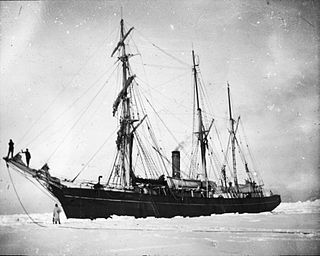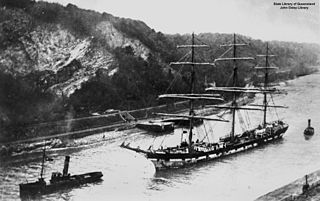Related Research Articles

A brig is a type of sailing vessel defined by its rig: two masts which are both square-rigged. Brigs originated in the second half of the 18th century and were a common type of smaller merchant vessel or warship from then until the latter part of the 19th century. In commercial use, they were gradually replaced by fore-and-aft rigged vessels such as schooners, as owners sought to reduce crew costs by having rigs that could be handled by fewer men. In Royal Navy use, brigs were retained for training use when the battle fleets consisted almost entirely of iron-hulled steamships.

Nimrod was a wooden-hulled, three-masted sailing ship with auxiliary steam engine that was built in Scotland in 1867 as a whaler. She was the ship with which Ernest Shackleton made his Nimrod Expedition to Antarctica in 1908–09. After the expedition she returned to commercial service, and in 1919 she was wrecked in the North Sea with the loss of ten members of her crew.
SS Chenab was a steamship that was built in England in 1911 and scrapped in Scotland in 1953. For nearly two decades she was part of Nourse Line, which carried Girmityas from India to colonies in the Caribbean and the Pacific. In 1914 she was requisitioned for service in the First World War.

The Isthmian Steamship Company was a shipping company founded by US Steel in 1910.

The Type C4-class ship were the largest cargo ships built by the United States Maritime Commission (MARCOM) during World War II. The design was originally developed for the American-Hawaiian Lines in 1941, but in late 1941 the plans were taken over by the MARCOM.

SS El Oriente was a cargo ship built in 1910 for the Morgan Line, a subsidiary of the Southern Pacific Company. During World War I, she was known as USS El Oriente (ID-4504) in service with the United States Navy. At the end of war, she reverted to her original name of SS El Oriente. During World War II she was chartered by the International Committee of the Red Cross (ICRC) as SS Henri Dunant, but reverted to her original name of SS El Oriente at the end of the charter.

SS Empire Simba was a British steam-powered cargo ship. She was originally an American ship, launched in 1918 as SS West Cohas. During a stint in the United States Navy from 1918 to 1919, she was called USS West Cohas (ID-3253).
USS West Coast (ID-3315) was a cargo ship for the United States Navy during World War I. The ship was laid down as SS War Dagger but launched in July 1918 as SS West Coast and reverted to that name at the end of her Navy service.
SS Empire Bunting was a 6,318 GRT cargo ship which was built in 1919. She saw service between the wars under the US flag and was transferred to the UK Ministry of War Transport in the Second World War. She made a number of cross-Atlantic voyages, often sailing in convoys. She ended her career by being sunk as a blockship on the Normandy coast, supporting the allied landings there in 1944.
SS Comet may also refer to one of several commercial passenger steamships:

MV Loch Dunvegan is a Caledonian Maritime Assets Limited car ferry built for the Isle of Skye crossing and now operating in the Kyles of Bute, Argyll and Bute, Scotland. She is operated by Caledonian MacBrayne (CalMac).
Sam Cearns was a British ship-rigged sailing cargo ship and emigrant carrier, built in 1864. In 1871 she was wrecked near Tierra del Fuego after the crew members gallantly saved the crew of another windjammer Knight Errant.

SS Cape Gibson (AK-5051) was a Cape G Class Break bulk cargo ship of the United States Maritime Administration, last used as a training ship at Texas A&M University at Galveston before being scrapped in 2020.

The Type R ship is a United States Maritime Administration (MARAD) designation for World War II refrigerated cargo ship, also called a reefer ship. The R type ship was used in World War II, Korean War, Vietnam War and the Cold War. Type R ships were used to transport perishable commodities which require temperature-controlled transportation, such as fruit, meat, fish, vegetables, dairy products and other foods. The US Maritime Commission ordered 41 new refrigerated ships for the US Navy. Because of the difficulty of building refrigerated ships only two were delivered in 1944, and just 26 were delivered in 1945 and the remainder in 1946–48. The 41 R type ships were built in four groups. Two of design types were modified type C1 ships and two were modified type C2 ships. The United Fruit Company operated many of the R type ships in World War II. The type R2-S-BV1 became the US Navy Alstede-class stores ship and the type R1-M-AV3 became the US Navy Adria-class stores ship.
SS Ruahine was a UK-built ocean liner and refrigerated cargo ship. She was launched in 1909 in Scotland for the New Zealand Shipping Company, who operated her in scheduled service between Britain and New Zealand. She survived both World wars.
USS Herald of the Morning was a C2-S-B1 Maritime Commission hull that served in heavy combat in the Pacific Theatre during World War II as a merchant and United States Navy vessel.

Cromartyshire was an iron-hulled sailing cargo ship that was launched in Scotland in 1879. She was named after the county of Cromartyshire in the Scottish Highlands.
References
- ↑ Colledge, J. J. (1970). Ships of the Royal Navy: An Historical Index, Vol.2. Newton Abbot: David & Charles. p. 195.
- ↑ "Kensington". Scottish Built Ships. Caledonian Maritime Research Trust. Archived from the original on 24 February 2024. Retrieved 24 February 2024.
- ↑ "Knight Errant (1091273)" . Miramar Ship Index . Retrieved 2024-02-24.
- ↑ Weisman, Matthew J.; Shorf, Paula (2016). "Boats Built at Toledo, Ohio" (PDF). Port of Toledo. p. 92. Archived from the original (PDF) on 27 February 2023. Retrieved 24 February 2024.
- ↑ "Kensington Court". Scottish Built Ships. Caledonian Maritime Research Trust. Archived from the original on 24 February 2024. Retrieved 24 February 2024.
- ↑ "Old Kensington (1070682)" . Miramar Ship Index . Retrieved 2024-02-24.